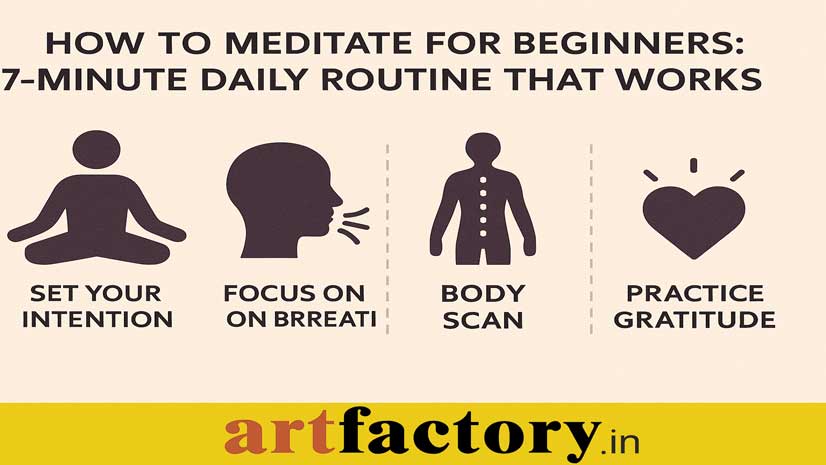
How to Meditate for Beginners: 7-Minute Daily Routine That Works
Are you new to meditation and wondering how to get started? You’re in the right place. In today’s fast-paced world, meditation can be your daily dose of calm, clarity, and control—even if you only have 7 minutes. This beginner-friendly guide will walk you through a simple yet powerful daily meditation routine that really works.
🧘♀️ Why Meditation is Life-Changing (Especially for Beginners)
Meditation isn’t just about sitting still—it’s about training your mind to stay present. Studies show that even a few minutes of daily meditation can:
Reduce stress and anxiety
Improve focus and attention
Boost emotional well-being
Enhance sleep quality
Promote self-awareness and compassion
And the best part? You don’t need hours—just 7 minutes a day can make a real difference.
🌅 7-Minute Daily Meditation Routine for Beginners
This step-by-step method is designed to help you build a habit without feeling overwhelmed. All you need is a quiet space and your breath.
Minute 1: Set Your Intention
Sit comfortably. Close your eyes. Ask yourself:
“Why am I meditating today?”
Whether it’s to feel calm, focused, or grateful—set a purpose.
Minutes 2–3: Focus on Your Breath
Gently bring your attention to your breathing. Inhale slowly through your nose for 4 counts. Exhale through your mouth for 6 counts. Repeat.
If your mind wanders, that’s normal—just bring it back.
Minutes 4–5: Body Scan
Start from the top of your head and slowly bring awareness down your body—face, shoulders, chest, stomach, legs, and feet.
Release tension as you go.
This builds mind-body connection and relaxes your nervous system.
Minutes 6–7: Practice Gratitude
Think of 3 things you’re grateful for today. They can be simple: your breath, a loved one, a good meal.
Smile gently. Feel the energy shift within.
🛑 Common Meditation Myths (That Stop Beginners From Starting)
❌ “I don’t have time.”
You only need 7 minutes. That’s less than 1% of your day.
❌ “I can’t stop my thoughts.”
You’re not supposed to. Meditation is about observing, not eliminating thoughts.
❌ “I’m not doing it right.”
There’s no perfect way. The only “wrong” way is not showing up.
📍 Where to Meditate: Creating a Calm Space
You don’t need a fancy yoga room. Just choose a quiet corner with:
A cushion or chair
Soft lighting or natural light
Optionally: incense, candle, or calming music
⏰ When Should You Meditate?
The best time is when you’re least likely to be interrupted. For most people, it’s:
Morning: Sets the tone for a peaceful day
Night: Helps unwind and improves sleep
Pro Tip: Set a reminder or tie it to a habit (like brushing your teeth).
🧘 Helpful Tools for Meditation Beginners
Timer app (like Insight Timer, Calm, or Headspace)
Soft background music or nature sounds
Guided meditations on YouTube or Spotify
Journaling your thoughts afterward
🌱 Stay Consistent: Small Daily Steps Lead to Big Results
Start with just 7 minutes every day for 7 days. Track your progress. Celebrate your wins. Meditation isn’t about perfection—it’s about presence.
💬 Final Thoughts: Meditation Is a Gift You Give Yourself
Meditation doesn’t require robes, rituals, or retreats. It only requires your presence and a few minutes of your time. The 7-minute routine above is your gateway to greater clarity, calm, and confidence—starting today.
📌 FAQs on Meditation for Beginners
Q1: Can I meditate lying down?
Yes, but it’s easier to fall asleep. Sitting upright is ideal.
Q2: What if I get distracted?
That’s normal. Gently return your focus to your breath.
Q3: Is guided meditation better?
Both silent and guided meditations work. Try both and choose what suits you.

Comments : (0)